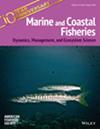Trophic level influences larval Shortbelly Rockfish development
Abstract
Objective
Early life success of fishes is considered one of the most important drivers of recruitment to adult populations, and elucidating the governing mechanisms is important for management efforts. Many hypotheses over the past century have been proposed to explain recruitment fluctuation, with the recently postulated Trophic Efficiency in Early Life (TEEL) hypothesis arguing that a shorter food chain length equals greater energy transfer efficiency from primary producers to larval fishes, thereby reducing early-life mortality and ultimately leading to stronger recruitment. Under TEEL it would then be assumed that feeding low in the food chain would improve growth and body condition, as these are often shown to be associated with increased survival in larval fishes. The objective of this study was to test this aspect of the TEEL hypothesis by quantifying condition, growth, and trophic level of larval Shortbelly Rockfish Sebastes jordani collected by the California Cooperative Oceanic Fisheries Investigations program and archived at the Ichthyoplankton Collection.
Methods
The trophic level on larval Shortbelly Rockfish was assessed with compound-specific isotopic analysis of amino acids. Their size at age and survival were estimated with otolith microstructure. Their diet was examined through stomach content analysis.
Result
Observations indicate that larvae consuming prey at a lower trophic level have greater body weight and exhibit faster growth rates. However, feeding at a lower trophic level did not influence body length. The ingested prey responsible for the lower trophic level within larval rockfish could not be determined.
Conclusion
Larval Shortbelly Rockfish consuming prey at a lower trophic level garnered greater body weight and exhibited faster growth rates and provides support for the TEEL hypothesis. However, further research is needed to identify the preferred prey(s) responsible for the more efficient energy transfer.


 求助内容:
求助内容: 应助结果提醒方式:
应助结果提醒方式:


